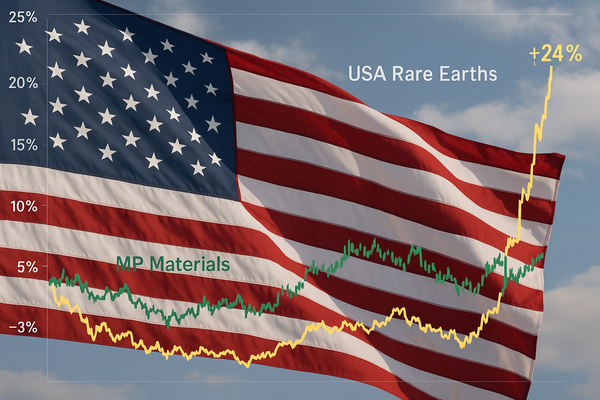
Archer Aviation (NYSE:ACHR) surges after a reported $500 million aircraft order and a U.S. air-taxi launch, while Automatic Data Processing (NASDAQ:ADP) stunned markets with a September payroll miss of 32,000 private-sector jobs. The headlines matter now because they push speculative growth momentum and short-term Fed expectations in opposite directions: Archer’s commercial milestones accelerate a commercialization story, while ADP’s data shortfall increases calls for earlier rate relief. U.S. markets react immediately; Europe and Asia watch policy signals and capital flows. Historically, big pre-revenue order announcements have lifted eVTOL peers, but certification and delivery risk remain high.
The headlines
Archer Aviation (NYSE:ACHR) climbed 13.65% to close at $11.57 after the company disclosed a roughly $500 million order and publicized plans for an air taxi launch in the United States. The rally marked a third straight up day for ACHR and placed the stock among the top performers for the session. Investors bid the shares higher on tangible commercial traction: headline orders give the market a revenue narrative beyond prototypes and trials.
Automatic Data Processing (NASDAQ:ADP) reported an unexpected loss of 32,000 private-sector jobs for September. That miss arrived at a sensitive moment. A U.S. government shutdown delayed the Bureau of Labor Statistics release, elevating ADP’s report to primary market focus. Traders responded by increasing odds for earlier Federal Reserve easing; several market observers now expect two rate cuts in 2025. The immediate effect was a tilt toward risk assets and higher sensitivity to incoming labor data.
Sector pulse
The stories reveal two intersecting themes that are shaping investor behavior this week. First, commercialization milestones are driving valuation re-rates in nascent mobility plays. Orders and launch dates convert long-dated optionality into nearer-term revenue potential. That lifts stocks that can show bookings or binding contracts.
Second, macro data reliability has become a market-moving factor while official releases pause. ADP’s miss highlights the fragility of relying on alternate data sources when government statistics are unavailable. That fragility feeds volatility in rate-sensitive sectors. In the short term, lower-than-expected payrolls push expectations for Fed easing forward, which typically increases appetite for growth names. Over the long term, persistent weak jobs readings would lower discount rates further and potentially support higher multiples for long-duration equities — but only if earnings and cash flows follow.
Internationally, the impact is uneven. In Europe, central banks are still reacting to local inflation dynamics, so a single U.S. payroll surprise matters most through global fund flows and currency moves. In Asia, policymakers watch capital reallocation: easier U.S. policy often strengthens local equity rallies, but export-dependent economies monitor demand signals from the U.S. consumer.
Winners & laggards
Archer Aviation (NYSE:ACHR) — winner. The $500 million order and a stated U.S. air-taxi launch provide concrete milestones that investors can price in. Strengths: demonstrable commercial demand, media attention that attracts retail and institutional momentum, and a clearer go-to-market story. Risks: certification timelines, supply-chain bottlenecks for batteries and motors, unit economics for short urban routes, and capital needs to fund production ramp. The stock’s jump to $11.57 reflects the market re-pricing optionality into nearer-term value, but valuation remains sensitive to delivery schedules and margin assumptions.
Automatic Data Processing (NASDAQ:ADP) — mixed/laggard in sentiment terms. A reported loss of 32,000 jobs is significant because ADP’s monthly report is a widely used private-sector snapshot. Opportunities: ADP’s data can outperform when official reports resume, giving the firm relevance and revenue from analytics. Risks: credibility questions if private payroll measures repeatedly diverge from BLS figures; trading moves show how a single miss can swing rate expectations and short-term flows. The immediate market impact is more about policy than ADP’s core business, but repeated misses could undermine investor confidence in private payroll proxies.
How investors should read positioning: short-term money flows toward growth on the prospects of policy easing. That boosts speculative, news-driven names such as ACHR. Longer-term capital allocators, however, will weigh execution risk and cash runway before committing. ADP’s miss raises the bar for clarity on labor trends when the official reports return.
What smart money is watching next
- Archer delivery and certification milestones — binding delivery schedules, FAA certification updates, and any disclosure of customer payment terms. A confirmed delivery timeline or non-refundable deposits would materially improve revenue visibility.
- ADP’s October payroll release and the timing of the Bureau of Labor Statistics’ next official jobs report. Markets will compare private and public data to assess whether September’s miss was an outlier or the start of a broader slowdown.
- Federal Reserve signals and economic datapoints: the next CPI, ISM surveys, and Fed minutes. Traders are pricing roughly two cuts in 2025; any inflation surprise or stronger-than-expected labor data could push that view back.
Closing take-away
The single most important insight for investors is this: concrete commercial moves can quickly reshape sentiment in speculative growth plays, but macro data risk now has outsized power to change the backdrop for those gains. Archer’s order and launch announcements convert long-term optionality into nearer-term narratives. ADP’s payroll miss, by contrast, changes near-term interest-rate expectations and therefore the financing and valuation context for high-growth, capital-intensive firms. For investors, that means watching execution milestones closely while keeping a short leash on macro surprises that can swing the entire market’s cost of capital.
Note: This article is informational only and does not constitute investment advice. It summarizes reported developments for Archer Aviation (NYSE:ACHR) and Automatic Data Processing (NASDAQ:ADP) based on recent news.








